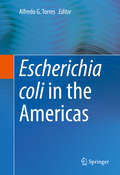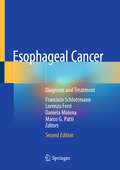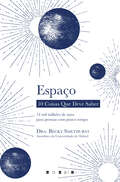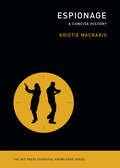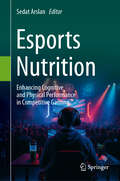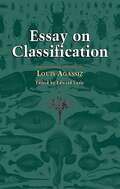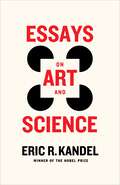- Table View
- List View
Escape: Book 2 (Chase Ser. #2)
by Linwood BarclayDon't stop running . . . the second edge-of-your-seat thriller with bite from international bestselling author Linwood Barclay for ages 9+12-year-old Jeff and genetically engineered spy dog Chipper are on the run from the mysterious and sinister government organisation knows only as The Institute. Due to a combination of bravery, luck and some of Chipper's more useful modifications, they've managed to evade their pursuers so far. But The Institute is closing in and Chipper and Jeff will have to be stay one step ahead if they want to stay alive..Danger, secrets and thrilling suspense collide in Linwood Barclay's action-packed series for children.
Escaping From Predators
by Daniel T. Blumstein Cooper, William E. Jr. and Blumstein, Daniel T. William E. Cooper Jr.When a predator attacks, prey are faced with a series of 'if', 'when' and 'how' escape decisions – these critical questions are the foci of this book. Cooper and Blumstein bring together a balance of theory and empirical research to summarise over fifty years of scattered research and benchmark current thinking in the rapidly expanding literature on the behavioural ecology of escaping. The book consolidates current and new behaviour models with taxonomically divided empirical chapters that demonstrate the application of escape theory to different groups. The chapters integrate behaviour with physiology, genetics and evolution to lead the reader through the complex decisions faced by prey during a predator attack, examining how these decisions interact with life history and individual variation. The chapter on best practice field methodology and the ideas for future research presented throughout, ensure this volume is practical as well as informative.
Escaping Gravity: My Quest to Transform NASA and Launch a New Space Age
by Lori GarverA former NASA deputy administrator recounts how she battled greed and corruption to revolutionize the agency and usher in a new space age.Escaping Gravity is former NASA Deputy Administrator Lori Garver’s firsthand account of how a handful of revolutionaries overcame the political patronage and bureaucracy that threatened the space agency. The success of Elon Musk’s SpaceX, Jeff Bezos’s Blue Origin, Richard Branson’s Virgin Galactic, and countless other commercial space efforts were preceded by decades of work by a group of people Garver calls “space pirates.” Their quest to transform NASA put Garver in the crosshairs of Congress, the aerospace industry, and hero-astronauts trying to protect their own profits and mythology within a system that had held power since the 1950s.As the head of the NASA transition team for President-elect Barack Obama and second-in-command of the agency, Garver drove policies and funding that enabled commercial competition just as the capabilities and resources of the private sector began to mature. She was determined to deliver more valuable programs, which required breaking the self-interested space-industrial cycle that, like the military, preferred to spend billions of taxpayer dollars on programs aimed to sustain jobs and contracts in key congressional districts. The result: more efficiency and greater progress.Including insider NASA conversations and insights on how the US space industry has been transformed to become the envy of the world and is ushering in a new space age, Escaping Gravity offers a blueprint for how to drive productive and meaningful change.Praise for Escaping Gravity“Former NASA official Lori Garver offers a front-row seat to the decades-long struggles within and among space bureaucrats and space billionaires. Bring popcorn, as you bear witness to an untold slice of space history.” —Neil deGrasse Tyson, Astrophysicist and author of Space Chronicles: Facing the Ultimate Frontier“We are living at the most exciting time in space exploration since the Apollo era, in part because the world’s largest space agency, NASA, got around to trying something new, the funding of commercial crews. Lori Garver tells it like it is . . . or was for a woman effecting change at NASA despite men of the military industrial complex—and their cost-plus contracts. It wasn’t rocket science, it was much harder than that. Don’t take my word(s) for it; read this book.” —Bill Nye, CEO, The Planetary Society“A scathing memoir that shows the ugly side of NASA while offering hope for a better future for the space agency.” —Kirkus Reviews
Escaping Nature: How to Survive Global Climate Change
by Orrin H. Pilkey Keith C. Pilkey Norma J. Longo Hannah L. Hayes Charles O. Pilkey Linda P. Pilkey-Jarvis Fred B. DodsonIndustrial and agricultural greenhouse gas emissions are rapidly warming Earth’s climate, unleashing rising seas, ocean acidification, melting permafrost, powerful storms, wildfires, floods, deadly heat waves, droughts, tsunamis, food shortages, and armed conflict over shrinking water supplies while reducing nutritional levels in crops. Billions of people will become climate refugees. Hotter temperatures will allow tropical diseases to spread into temperate regions. Higher levels of CO2, allergens, dust, and other particulate matter will impair our physical and mental health and even reduce our cognitive abilities. Climate change disproportionately affects the world’s poor. It also harms Nature, and could ultimately trigger a sixth mass extinction. In Escaping Nature, Orrin H. Pilkey and his coauthors offer concrete suggestions for how to respond to the threats posed by global climate change. They argue that while we wait for the world’s governments to get serious about mitigating climate change we can adapt to a hotter world through technological innovations, behavioral changes, nature-based solutions, political changes, and education.
Escaping from Eden: Does Genesis Teach that the Human Race was Created by God or Engineered by ETs?
by Paul Wallis'This generation's 'Chariots of the Gods'', George Noory, Coast to Coast AMThe familiar stories of the book of Genesis affirm that God made the universe, planet earth, and you and me. However, various anomalies in the text clue us that we are not reading the original version of these stories. So what were the original narratives and what did they say about who we are and where we all came from? What was the earlier story of human origins, almost obliterated from the Hebrew Scriptures in the 6th century BC, and suppressed from Christian writing in the 2nd and 3rd centuries AD? And what does any of this have to do with Extra Terrestrials? Escaping from Eden will take you on a journey around the world and into the mythologies of ancient Sumeria, Mesoamerica, India, Africa, and Greece to reveal a profound secret, hidden in plain sight in the text of the Bible. Far reaching and deeply controversial, this book points to truths about ourselves, the universe and everything that you may have long suspected but not dared to speak!
Escaping the Rabbit Hole: How to Debunk Conspiracy Theories Using Facts, Logic, and Respect (Revised and Updated - Includes Information about 2020 Election Fraud, The Coronavirus Pandemic, The Rise of QAnon, and UFOs)
by Mick WestRevised and updated for the first time in 2023—Now includes strategies for debunking conspiracies regarding the coronavirus pandemic, election fraud, QAnon, UFOs, and more. The Earth is flat, the World Trade Center collapse was a controlled demolition, planes are spraying poison to control the weather, and actors faked the Sandy Hook massacre. All these claims are bunk: falsehoods, mistakes, and in some cases, outright lies. But many people passionately believe one or more of these conspiracy theories. They consume countless books and videos, join like-minded online communities, try to convert those around them, and even, on occasion, alienate their own friends and family. Why is this, and how can you help people, especially those closest to you, break free from the downward spiral of conspiracy thinking? In Escaping the Rabbit Hole, author Mick West shares over a decade&’s worth of knowledge and experience investigating and debunking false conspiracy theories through his forum, MetaBunk.org, and sets forth a practical guide to helping friends and loved ones recognize these theories for what they really are. Perhaps counter-intuitively, the most successful approaches to helping individuals escape a rabbit hole aren&’t comprised of simply explaining why they are wrong; rather, West&’s tried-and-tested approach emphasizes clear communication based on mutual respect, honesty, openness, and patience. West puts his debunking techniques and best practices to the test with the most popular false conspiracy theories today (Chemtrails, The Coronavirus Pandemic, 9/11 Controlled Demolition, Election Fraud, False Flags, Flat Earth, The Rising of QAnon, and UFOs)—providing road maps to help you to understand your friend and help them escape the rabbit hole. These are accompanied by real-life case studies of individuals who, with help, were able to break free from conspiracism. With sections on: the wide spectrum of conspiracy theoriesavoiding the &“shill&” labelpsychological factors and other complications(and concluding with) a look at the future of debunking Mick West has put forth a conclusive, well-researched, practical reference on why people fall down the conspiracy theory rabbit hole and how you can help them escape.
Eschatology as Imagining the End: Faith between Hope and Despair (Routledge New Critical Thinking in Religion, Theology and Biblical Studies)
by Sigurd BergmannAs society becomes more concerned with the future of our planet, the study of apocalypse and eschatology become increasingly pertinent. Whether religious or not, peoples’ views on this topic can have a profound effect on their attitudes to issues such as climate change and social justice and so it cannot be ignored. This book investigates how different approaches in historical and contemporary Christian theology make sense in reflecting about the final things, or the eschata, and why it is so important to consider their multi-faceted impact on our lives. A team of Nordic scholars analyse historical and contemporary eschatological thinking in a broad range of sources from theology and other related disciplines, such as moral philosophy, art history and literature. Specific social and environmental challenges, such as the Norwegian Breivik massacre in 2011, climatic change narratives and the ambiguity of discourses about euthanasia are investigated in order to demonstrate the complexity and significance of modes of thinking about the end times. This book addresses the theology of the end of the world in a more serious academic tone than it is usually afforded. As such, it will be of great interest to academics working in eschatology, practical theology, religious studies and the philosophy of religion.
Escherichia coli in the Americas
by Alfredo G. TorresBacterial diarrheal diseases remain an important leading cause of preventable death, especially among children under five in developing countries. In the American continent, diarrheal disease and other health complications caused by Escherichia coli constitute a major public health problem, and, therefore, several research groups have dedicated their effort to understand this pathogen and provide feasible solutions to prevent, treat and reduce E. coli infections. The Latin American Coalition for Escherichia coli Research (LACER) was created as a multidisciplinary network of international research groups working with E. coli with the ultimate goal of advancing understanding of E. coli, and to prepare the next generation of American E. coli investigators. As such, this book compiles the knowledge of these investigators about E. coli, a commensal bacteria living inside its host, and a pathogen causing disease in animals and humans. Escherichia coli in the Americas contains a series of 15 chapters written by experts, covering basic concepts regarding the different categories of E. coli, including their environmental niche, virulence mechanisms, host reservoir, and disease outcomes, as well as diagnosis, vaccine development and treatment. This book's target audience include trainees and students learning about the basic and clinical aspects of E. coli pathogenesis, as well as experts around the globe who wish to learn more about this pathogen and the public health impact this bacteria has in America.
Escherichia coli, a Versatile Pathogen (Current Topics in Microbiology and Immunology #416)
by Gad Frankel Eliora Z RonEscherichia coli is a facultative anaerobic Gamma-proteobacterium, which belongs to the family Enterobacteriaceae. While being an important constituent of the normal gut microbiota, specialized E. coli clones have acquired genetic elements that allow them to compete with the endogenous commensals, colonise normally sterile niches and cause disease. E. coli pathotypes can cause intestinal and extra intestinal infections (e.g. UTI, sepsis) and associate with mammalian cells while being extra- or intra-cellular. In recent years, E. coli infections have become a serious clinical problem, due to the rapid spread of antibiotic resistance. Thus, infections with intestinal E. coli (e.g. E. coli O104) or extraintestinal pathogenic strains (e.g. E. coli ST131) are becoming difficult to treat and are often lethal. Consequently, there is a pressing need to develop alternative control measures, including the identification of new drug targets and development of vaccines that offer lasting protection. This volume focuses on several types of E. coli infections (intestinal and extraintestinal), virulence factors, and E. coli pandemics. It addresses the problem of antibiotic resistance, and a dedicated chapter discusses the need to develop alternative control measures. Given its depth and breadth of coverage, the book will benefit all those interested in the biology, genetics, physiology and pathogenesis of E. coli, and in related vaccine development.
Eselsbrücken zur Chemie – bequeme Zugänge zu einer schwierigen Wissenschaft: Für alle, die Chemie lernen wollen oder sollen (essentials)
by Dieter NeubauerDieter Neubauer gibt vielfältige Beispiele für das Einprägen von Strukturformeln und chemischen Fakten. Denn Wortassoziationen, Bilder und Bildfolgen, Piktogramme oder Merksprüche können helfen, das schwierige Fach Chemie zu erlernen. Das Ergebnis ist ein unterhaltsamer Streifzug durch die Geschichte der Merksprüche und eine Anleitung zum Erstellen von Eselsbrücken und ihren Verwandten.
Esmorzar amb partícules: La ciència com mai no s'ha explicat
by Francesc Miralles Sonia Fernández VidalTens a les mans un assaig sobre física quàntica, així és. Un moment, per favor, ¡espera! No t'espantis ni deixis anar el llibre de cop. Acceptaries una invitació a esmorzar? Si acceptes aquesta proposició i t'aventures a navegar entre aquestes pàgines, descobriràs un univers tan meravellós com desconcertant. La teoria quàntica és una de les més belles i fascinants de la ciència. Les regles que segueix són esbojarrades si les comparem amb el nostre dia a dia. Són antiintuïtives. Quan ens endinsem en el món quàntic es qüestionen les nostres creences sobre la realitat, també les de la nostra realitat quotidiana. Sonia Fernández-Vidal, escriptora i doctora en física quàntica, i Francesc Miralles, escriptor i periodista, ens conviden a un esmorzar molt divertit al qual també assistiran Newton, Einstein, Heisenbergi altres físics famosos de la història. Entre magdalenes, torrades, cafè amb llet i sucs de taronja, emprendrem un viatge excitant i revelador als orígens de l'univers. Aprendrem per a què serveix l'accelerador de partícules, què és la partícula de Déu, com és que les coses poden ser a dos llocs alhora i intentarem comprendre els misteris de l'existència.
Esophageal Cancer: Diagnosis and Treatment
by Marco G. Patti Francisco Schlottmann Daniela MolenaThis book provides comprehensive and practical guidance for the management of esophageal cancer. It presents a detailed review of the pathophysiology, clinical staging, treatment, and outcomes of patients with esophageal cancer. Chapters cover the epidemiology of the disease, latest diagnostic and staging tools, systemic therapies, and the current open and minimally invasive surgical techniques including transhiatal, Ivor Lewis and McKeown esophagectomy. Esophageal Cancer: Diagnosis and Treatment compiles experience gained across a variety of medical disciplines, with contributions from world renowned surgeons, gastroenterologists, and medical oncologists. Thanks to its multidisciplinary authorship, this book represents a unique resource for anybody who takes care of patients with esophageal cancer.
Esophageal Cancer: Diagnosis and Treatment
by Marco G. Patti Lorenzo Ferri Francisco Schlottmann Daniela MolenaThis book provides comprehensive and practical guidance for the management of esophageal cancer. It presents a detailed review of the pathophysiology, clinical staging, treatment, and outcomes of patients with esophageal cancer. Chapters cover the epidemiology of the disease, latest diagnostic and staging tools, systemic therapies, and the current open and minimally invasive surgical techniques including transhiatal, Ivor Lewis and McKeown esophagectomy. Esophageal Cancer: Diagnosis and Treatment compiles experience gained across a variety of medical disciplines, with contributions from world renowned surgeons, gastroenterologists, and medical oncologists. Thanks to its multidisciplinary authorship, this book represents a unique resource for anybody who takes care of patients with esophageal cancer.
Espaço: 10 Coisas Que Deve Saber
by Becky SmethurstUma visita guiada ao espaço que revela teorias fascinantes, descobertas surpreendentes e mistérios que subsistem na astronomia e na astrofísica modernas. Antes do Big Bang, tempo, espaco e matéria nao existiam. Nos 14 mil milhões de anos que se seguiram, os cientistas apontaram os seus telescópios para o céu e desenvolveram teorias para explicar os fenómenos estranhos e maravilhosos que observaram. Através dessas observações, agora entendemos conceitos como o tamanho do universo (ainda em expansão), a distância até à estrela mais próxima da Terra ou o que impulsiona a formação de planetas, galáxias e buracos negros. Neste livro, a Dra. Becky Smethurst, astrofísica da Universidade de Oxford, apresenta tudo o que precisa de saber sobre o universo em dez lições simples e cativantes.Como sabemos que o Big Bang aconteceu? O que é a matéria escura? Os extraterrestres existem? Se alguma vez olhou para o céu e se questionou sobre como tudo funciona, neste livro encontra respostas acessiveis, e muitas outras perguntas, num breve passeio pelo nosso extraordinário universo. «Um pequeno livro que reúne tudo o que precisa para viajar pelo cosmos.» Chris Lintott, professor de Astrofísica na Universidade de Oxford
Esperimenti didattici e amatoriali con i contatori Geiger: 50+ attività per principianti e non solo
by Francesco RiggiQuesto libro offre una raccolta completa di esperimenti introduttivi alla fisica dei raggi cosmici e alla fisica nucleare utilizzando i contatori Geiger. Presenta oltre 50 esperimenti con brevi spiegazioni della fisica coinvolta, indicazioni sull'impostazione di esperimenti didattici e amatoriali, mostrandone i risultati effettivi. Gli esperimenti coprono l'utilizzo dei contatori Geiger per rilevare radiazioni alfa, beta, gamma e raggi cosmici, valutare le prestazioni di un rivelatore, monitorare il livello di radiazioni in vari ambienti, condurre esperimenti di coincidenza e applicare nozioni di statistica e algoritmi di analisi dati. I capitoli introduttivi approfondiscono inoltre i princìpi basilari delle radiazioni, i processi di interazione della radiazione con la materia e la storia dei rivelatori di particelle, in particolare i contatori Geiger. Con la diffusa disponibilità di contatori Geiger moderni ed economici e di dispositivi fai-da-te, molti esperimenti sono adatti anche agli studenti delle scuole superiori e universitari, in linea con i moderni programmi di studio della fisica. L'autore ha condotto personalmente molti di questi esperimenti negli ultimi 20 anni con studenti di fisica del terzo anno. Il libro si rivolge anche agli scienziati dilettanti e ad un vasto pubblico interessato ad esplorare i fenomeni delle radiazioni e della loro rivelazione. Presenta circa 250 illustrazioni originali e riferimenti a esperimenti storici e scoperte contemporanee.
Espionage: A Concise History (The MIT Press Essential Knowledge series)
by Kristie MacrakisA concise introduction to the history and methods of espionage, illustrated by spy stories from antiquity to today&’s high-tech world.Espionage is one of the most secret of human activities. It is also, as the popularity of spy stories suggests, one of the most intriguing. This book pulls the veil back on the real world of espionage, revealing how spying actually works. In a refreshingly clear, concise manner, Kristie Macrakis guides readers through the shadowy world of espionage, from the language and practice of spycraft to its role in international politics, its bureaucratic underpinnings, and its transformation in light of modern technology. Espionage is a mirror of society and human foibles with the added cloak of secrecy and deception. Accordingly, Espionage traces spying all the way back to antiquity, while also moving beyond traditional accounts of military and diplomatic intelligence to shine a light on industrial espionage and the new techno-spy. As thorough—and thoroughly readable—as it is compact, the book is an ideal introduction to the history and anatomy of espionage.
Esports Nutrition: Enhancing Cognitive and Physical Performance in Competitive Gaming
by Sedat ArslanThis book provides an essential resource for understanding how targeted nutritional strategies can enhance cognitive and physical performance in competitive gaming. As esports continues to grow, players face unique challenges that require specialized nutritional approaches to optimize their skills. Chapters cover essential topics such as the impact of nutrition on cognitive functions including concentration, memory, and reaction time, as well as the physical demands of gaming and how nutrition can support muscle endurance and injury prevention. Readers will discover hydration strategies essential for mental and physical endurance, as well as an analysis of performance-enhancing substances such as caffeine and supplements. With unique insights into AI-driven personalized nutrition and tailored advice for female gamers, this book offers a holistic approach to esports nutrition. Combining the latest research and practical applications, this book is an invaluable resource not only for esports athletes, coaches, sports nutritionists, and healthcare professionals, but also for researchers interested in the intersection of nutrition, technology, and performance in competitive gaming.
Essay on Classification
by Louis AgassizA major influence on the development of American scientific culture, Swiss-born Louis Agassiz (1807–73) was one of the great scientists of his day. A student of anatomist Georges Cuvier, Agassiz adapted his teacher's pioneering techniques of comparative anatomy to paleontology, and he rose to prominence as a distinguished systematist, paleontologist, and educator. Agassiz introduced science to ordinary citizens to an unprecedented degree; people around the world read his books, sent him specimens, and consulted his opinion. Agassiz was also a staunch opponent of the theory of evolution, and he was among the last of the reputable scientists who continued to reject the concept after the publication of The Origin of the Species. All of nature bore testimony to a divine plan, Agassiz believed, and he could not reconcile himself to a theory that did not invoke God's design. Ironically, his 1851 Essay on Classification provided Darwin and other evolutionists with evidence from the fossil record to support the theory of natural selection. A treasure of historically valuable insights that contributed to the development of evolutionary biology, this volume introduced the landmark contention that paleontology, embryology, ecology, and biogeography are inextricably linked in classifications that reveal the true relationships between organisms. Its emphasis on advanced and original work gave major impetus to the study of science directly from nature, and it remains a classic of American scientific literature.
Essay on Machines in General: Text, Translations and Commentaries. Lazare Carnot's Mechanics - Volume 1 (Logic, Epistemology, and the Unity of Science #47)
by Raffaele Pisano Jennifer Coopersmith Murray PeakeThis book offers insights relevant to modern history and epistemology of physics,mathematics and, indeed, to all the sciences and engineering disciplines emergingof 19th century. This research volume is the first of a set of three Springer books onLazare Nicolas Marguérite Carnot’s (1753–1823) remarkable work: Essay on Machines inGeneral (Essai sur les machines en général [1783] 1786). The other two forthcomingvolumes are: Principes fondamentaux de l’équilibre et du mouvement (1803) andGéométrie de position (1803).Lazare Carnot – l'organisateur de la victoire – in Essai sur le machine en général (1786)assumed that the generalization of machines was a necessity for society and its economicdevelopment. Subsequently, his new coming science applied to machines attractedconsiderable interest for technician, as well, already in the 1780’s. With no lack inrigour, Carnot used geometric and trigonometric rather than algebraic arguments, andusually went on to explain in words what the formulae contained. His main physical–mathematical concepts were the Geometric motion and Moment of activity–concept ofWork . In particular, he found the invariants of the transmission of motion (by statingthe principle of the moment of the quantity of motion) and theorized the condition ofthe maximum efficiency of mechanical machines (i.e., principle of continuity in thetransmission of power).While the core theme remains the theories and historical studies of the text, the bookcontains an extensive Introduction and an accurate critical English Translation –including the parallel text edition and substantive critical/explicative notes – of Essaisur les machines en général (1786). The authors offer much-needed insight into therelation between mechanics, mathematics and engineering from a conceptual, empiricaland methodological, and universalis point of view. As a cutting–edge writing byleading authorities on the history of physics and mathematics, and epistemologicalaspects, it appeals to historians, epistemologist–philosophers and scientists (physicists, mathematicians and applied sciences and technology).
Essays In Social Neuroscience
by John T. Cacioppo Gary G. BerntsonLeaders in the field provide an introduction to the multidisciplinary collaborations of social neuroscience.
Essays in Humanism
by Albert EinsteinThe great thinker reflects on such topics as nuclear weapons, world poverty, and international affairs in this Wall Street Journal bestseller. Nuclear proliferation, Zionism, and the global economy are just a few of the insightful and surprisingly prescient topics scientist Albert Einstein discusses in this volume of collected essays from between 1931 and 1950. Written with a clear voice and a thoughtful perspective on the effects of science, economics, and politics in daily life, Einstein&’s essays provide an intriguing view inside the mind of a genius addressing the philosophical challenges presented during the turbulence of the Great Depression, the Second World War, and the dawn of the Cold War.This authorized ebook features rare photos and never-before-seen documents from the Albert Einstein Archives at the Hebrew University of Jerusalem.
Essays in Science
by Albert EinsteinThe Authorized Albert Einstein Archives Edition: An homage to the men and women of science, and an exposition of Einstein&’s place in scientific history. In this fascinating collection of articles and speeches, Albert Einstein reflects not only on the scientific method at work in his own theoretical discoveries, but also eloquently expresses a great appreciation for his scientific contemporaries and forefathers, including Johannes Kepler, Isaac Newton, James Clerk Maxwell, Max Planck, and Niels Bohr. While Einstein is renowned as one of the foremost innovators of modern science, his discoveries uniquely his own, through his own words it becomes clear that he viewed himself as only the most recent in a long line of scientists driven to create new ways of understanding the world and to prove their scientific theories. Einstein&’s thoughtful examinations explain the &“how&” of scientific innovations both in his own theoretical work and in the scientific method established by those who came before him.This authorized ebook features a new introduction by Neil Berger, PhD, and an illustrated biography of Albert Einstein, which includes rare photos and never-before-seen documents from the Albert Einstein Archives at the Hebrew University of Jerusalem.
Essays in Science
by Albert EinsteinThe Authorized Albert Einstein Archives Edition: An homage to the men and women of science, and an exposition of Einstein&’s place in scientific history. In this fascinating collection of articles and speeches, Albert Einstein reflects not only on the scientific method at work in his own theoretical discoveries, but also eloquently expresses a great appreciation for his scientific contemporaries and forefathers, including Johannes Kepler, Isaac Newton, James Clerk Maxwell, Max Planck, and Niels Bohr. While Einstein is renowned as one of the foremost innovators of modern science, his discoveries uniquely his own, through his own words it becomes clear that he viewed himself as only the most recent in a long line of scientists driven to create new ways of understanding the world and to prove their scientific theories. Einstein&’s thoughtful examinations explain the &“how&” of scientific innovations both in his own theoretical work and in the scientific method established by those who came before him.This authorized ebook features a new introduction by Neil Berger, PhD, and an illustrated biography of Albert Einstein, which includes rare photos and never-before-seen documents from the Albert Einstein Archives at the Hebrew University of Jerusalem.
Essays on Art and Science
by Eric R. KandelWhen we view a work of art, we often experience an emotional response, but the causes of our reactions are complex. Our knowledge of why we respond to art as we do is rooted in science—in psychology and biology. Eric R. Kandel traces the origins of this understanding to early twentieth-century Vienna, which gave rise to the concept of the “beholder’s share,” the realization that art is incomplete without the perceptual and emotional involvement of the viewer—that is, without our responses to it.But what causes our response? Our brain is a creativity machine that brings to bear on any image—including a painting—certain innate, universal processes related to sensory perception as well as higher-order processes related to our personal experiences, memories, and emotions. Understanding how these unconscious processes in the brain interact to create the beholder’s share is one of the great challenges currently confronting brain science.The essays on art and science in this book vary widely in subject matter, including the angst-ridden portraits of Soutine, conflicting views of women’s sexuality, Cubism’s challenge to our innate visual processes, and why we react differently to abstract versus figurative art. But each essay focuses on the interaction of art and science. Woven throughout are the many notable scientists, art historians, artists, and others, both Jewish and non-Jewish, who contributed to our understanding of how we experience art.
Essays on Astronomical History and Heritage: A Tribute to Wayne Orchiston on his 80th Birthday (Historical & Cultural Astronomy)
by Peter Robertson Steven GullbergThis multidisciplinary work celebrates Wayne Orchiston's career and accomplishments in historical and cultural astronomy on the occasion of his 80th birthday. Over thirty of the world’s leading scholars in astronomy, astrophysics, astronomical history, and cultural astronomy have come together to honor Wayne across a wide range of research topics. These themes include: • Astronomy and Society • Emergence of Astrophysics • History of Radio Astronomy • Solar System • Observatories and Instrumentation • Ethnoastronomy and ArcheoastronomyThis exceptional collection of essays presents an overview of Wayne’s prolific contributions to the field, along with detailed accounts of the book’s diverse themes. It is a valuable and insightful volume for both researchers and others interested in the fields of historical astronomy and cultural astronomy.






